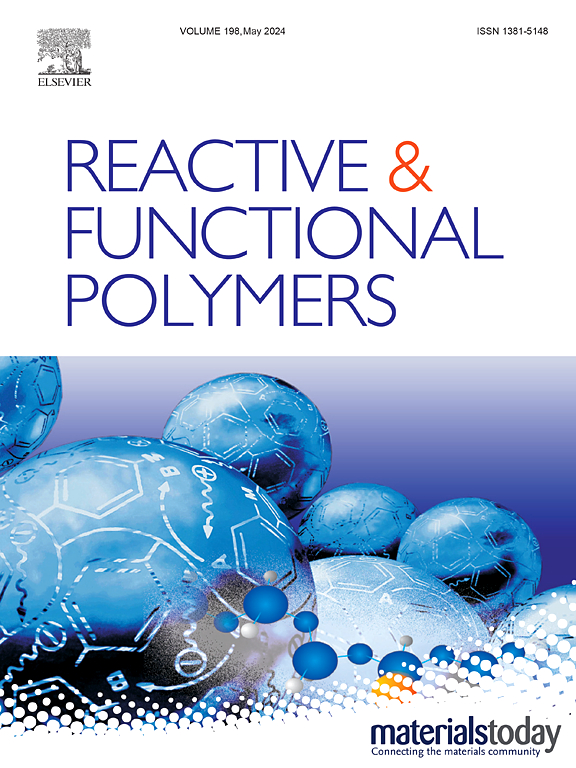Biporous polycaprolactone-like networks from 2-methylene-1,3-dioxepane: A versatile platform towards functional and reactive polyesters
IF 5.1
3区 工程技术
Q1 CHEMISTRY, APPLIED
引用次数: 0
Abstract
In this study, we report on the preparation of doubly porous “polycaprolactone-like” networks using a unique combination of 2-methylene-1,3-dioxepane, divinyl adipate, and either 2-chloroethyl vinyl ether or azidoethyl vinyl ether, allowing for the generation of functionalizable polyesters. Such reactive networks were synthesized via a free-radical ring-opening polymerization mechanism, employing a double porogen templating approach to generate a bimodal porosity. This resulted in macropores of around 200 μm generated after removal of a sieved and sintered NaCl template and smaller pores between 1 and 10 μm obtained through a phase separation process during the free-radical copolymerization of comonomers in the presence of a porogenic solvent. The incorporation of functional monomeric units into the copolymer backbone was evidenced by ATR-FTIR, while the concentration of reactive groups was controlled by finely adjusting the proportion of functional monomers in the copolymerization feed, as verified by EDX spectroscopy and elemental analysis. To demonstrate the versatility and potential applications of these functional degradable networks, a series of post-polymerization modifications was conducted. On the one hand, the pore surface associated with networks containing chloro pending groups was modified through nucleophilic substitution with different amino-compounds. On the other hand, for networks displaying azido groups at the pore surface, the Huisgen copper-catalyzed azide-alkyne cycloaddition modification was implemented for grafting a model fluorescent alkyne-modified compound. A comprehensive set of characterization techniques confirmed the successful completion of these post-polymerization modifications. These functionalized materials offer promising possibilities for applications in diverse fields, thanks to their tunable structure and physico-chemical properties, such as in biomedicine and notably for tissue engineering.

2-亚甲基-1,3-二氧基烷双孔聚己内酯类网络:功能和活性聚酯的通用平台
在这项研究中,我们报道了利用2-亚甲基-1,3-二氧基乙烷、己二酸二乙烯基和2-氯乙基乙烯醚或叠氮乙基乙烯醚的独特组合制备双孔“聚己内酯类”网络,从而生成功能化聚酯。这种反应网络是通过自由基开环聚合机制合成的,采用双孔模板方法产生双峰孔隙度。结果表明,经过筛分和烧结的NaCl模板去除后,形成了约200 μm的大孔,而在致孔溶剂存在下,共聚单体自由基共聚时,通过相分离过程形成了1 ~ 10 μm的小孔。ATR-FTIR证实了共聚物主链中含有功能单体,而EDX光谱和元素分析证实了通过精细调节共聚原料中功能单体的比例可以控制反应基团的浓度。为了证明这些功能性可降解网络的多功能性和潜在应用,进行了一系列聚合后改性。一方面,通过不同氨基化合物的亲核取代,修饰了含氯基团网络的孔表面。另一方面,对于在孔表面显示叠氮基团的网络,采用Huisgen铜催化叠氮-炔环加成改性,接枝了一个模型荧光炔修饰化合物。一套全面的表征技术证实了这些聚合后修饰的成功完成。由于其可调的结构和物理化学性质,这些功能化材料在生物医学和组织工程等各个领域的应用前景广阔。
本文章由计算机程序翻译,如有差异,请以英文原文为准。
求助全文
约1分钟内获得全文
求助全文
来源期刊

Reactive & Functional Polymers
工程技术-高分子科学
CiteScore
8.90
自引率
5.90%
发文量
259
审稿时长
27 days
期刊介绍:
Reactive & Functional Polymers provides a forum to disseminate original ideas, concepts and developments in the science and technology of polymers with functional groups, which impart specific chemical reactivity or physical, chemical, structural, biological, and pharmacological functionality. The scope covers organic polymers, acting for instance as reagents, catalysts, templates, ion-exchangers, selective sorbents, chelating or antimicrobial agents, drug carriers, sensors, membranes, and hydrogels. This also includes reactive cross-linkable prepolymers and high-performance thermosetting polymers, natural or degradable polymers, conducting polymers, and porous polymers.
Original research articles must contain thorough molecular and material characterization data on synthesis of the above polymers in combination with their applications. Applications include but are not limited to catalysis, water or effluent treatment, separations and recovery, electronics and information storage, energy conversion, encapsulation, or adhesion.
 求助内容:
求助内容: 应助结果提醒方式:
应助结果提醒方式:


